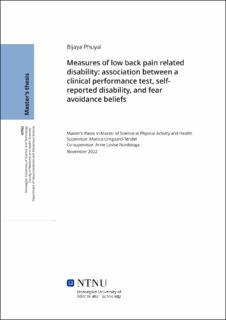| dc.description.abstract | Background: Patient’s self-report measures and clinician-measured performance tests are used to evaluate disability outcome in low back pain (LBP) patients. The level of agreement between self-report measure and clinical performance test are not well established. Furthermore, clinical performance test can be influenced by fear avoidance beliefs buts its relation is not fully understood.
Objective: We aimed to investigate the association of clinician measured performance test with self-reported disability and fear avoidance beliefs in patients with LBP.
Design: Cross-sectional observational exploratory study.
Methods: 44 patients with age above 16 years, receiving primary care physiotherapy were included. Clinician-measured performance test was evaluated with back performance scale (BPS), self-reported disability was evaluated with Oswestry Disability Index (ODI) and fear avoidance beliefs was evaluated with fear avoidance belief questionnaire for physical activity (FAB-PA) at baseline, three months, and nine months.
Results: Among the 44 included patients, 30 persons completed the study. At baseline, the correlation between BPS and ODI was weak, statistically significant with r=0.37 (p = 0.012) and there was no correlation between BPS and FAB-PA (r=0.06, p=0.704). At 3 months, the correlation between BPS and ODI was poor (r=0.27, p=0.089) and the correlation coefficient between BPS and FABQ-PA was weak, statistically significant with r=0.43 (p= 0.008). At 9 months, correlation between BPS and ODI was also weak with statistically significant at p = 0.015 with r= 0.44. There was no correlation between BPS and FAB-PA (r=0.21, p=0.275).
Conclusion: Clinician-scored performance test and self-reported measures was not, or only weakly correlated in the present study, and the instruments may reflect different aspects of the disability construct. If the results of the present study can be replicated, it supports the notion that multimethod, and multidimensional approaches should be used to obtain a more comprehensive assessment of physical function in patients with LBP. | |
